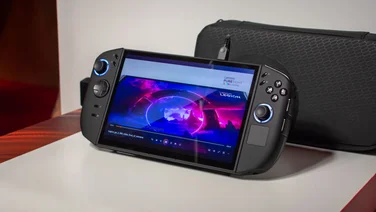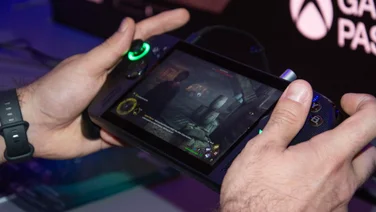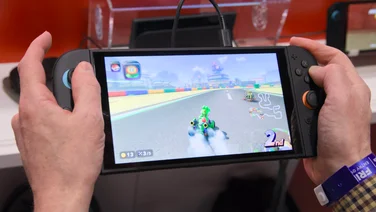To help us provide you with free impartial advice, we may earn a commission if you buy through links on our site. Learn more












There’s a new PlayStation Vita on sale, known as the PS Vita Slim or the PCH-2003. At first glance it looks simply like a slimmed down version of the original PS Vita; certainly nothing revolutionary. If it had been released six months ago the world probably would have largely shrugged and moved on, as the original device hasn’t been a huge success. However, with the barnstorming launch of the PS4, Sony will never get a better chance to revitalise its second attempt at a gaming handheld.
If you’re looking to buy a PS Vita for Remote Play then also consider the £45 PlayStation TV
The original PS Vita was launched two years ago, and although a few on our team actually went out and bought one, it has struggled to break out of a largely hardcore gaming niche – for example, at the time of writing, the highest rated title on Metacritic was Japanese RPG Persona 4. The hardware is powerful, it has dual analogue control sticks for modern console games and a big, bright, vibrant display, but there are problems too.

Firstly, it’s expensive: handheld consoles have traditionally appealed to kids but at over £200 the original Vita was a serious investment, and one with a big, vulnerable-looking display. The original console was also a bit on the heavy side and battery life wasn’t excellent either.
It’s not alone in the market, either. The Nintendo 3DS is cheaper, easier to tout about, has a protected screen when closed, a longer battery and a bigger range of software, yet even that struggled to reach the lofty heights of the original DS’s sales figures. The obvious answer is that both dedicated gaming handhelds are now in competition with iOS and Android devices.
As keen gamers, we still fervently believe in mobile gaming on dedicated devices, with developers creating games that play to the strengths of that device. But is that simply a minority view, and can the new PS Vita Slim help turn around the handheld’s fortunes and bring in new gamers, or is this to be Sony’s last handheld gaming device?
That’s the background done, so who’s going to be interested in buying a new PS Vita Slim? Well, we’d guess that there are three basic groups: those who own the original, love it, and want to know if they should ‘upgrade’ to the new version, those who always wanted one but were waiting for a hardware revision, and finally those who have recently bought a PS4 and want a PS Vita to accompany it.
PS VITA vs PS VITA SLIM
At present you can walk into a shop and buy both the old and new PS Vita models, with the older model being priced far more competitively as retailers clear their stocks. The new PS Vita Slim has an RRP of £180, that’s £50 less than when the original Vita launched, but around £10 more than you can pick up the old model for today, and the old Vita usually comes bundled with free games and a memory card too. So while stocks last, which Vita is best?

The new Vita Slim is practically identical in size when viewed front on (it’s fractionally longer and wider if measured), but pick it up and it’s noticeably slimmer and lighter than the original. Not including the protruding sticks and buttons, the new Slim is 15mm thick, compared to 18mm for the old model. Some of our staff thought the slimmer design was easier to hold, but more important was its lighter weight of 219g compared to 260g on the previous model. It’s not a radical change, but the new Vita sits far more comfortably in a coat pocket than the old one.

The controls are essentially identical, which is fine as the PS Vita’s controls have always been one of its strong points. The little analogue sticks are surprising accurate and comfortable to use and the d-pad and buttons are all responsive. The front-and-back touchscreen and touchpad provide lots of options for interaction, with the touchscreen tying in nicely with the PS4 controller’s touchpad in Remote Play (see below).
Our only misgiving is that Sony couldn’t find a way to add a second set of shoulder buttons somewhere, as this would seriously improve PS Remote Play and PlayStation Now compatibility in the future, as would have adding click-in buttons to the analogue sticks.
PS VITA SLIM DISPLAY
Beside being put on a diet, the biggest change on the new Vita Slim is that the original’s OLED display has been switched out for an LCD panel. Both displays are the same size and have the same resolution but to look at they are remarkably different. To our eyes there’s no competition between them unfortunately, the OLED display produces richer colours and has superior contrast.
Now we’ve been discussing the merits of OLED vs LCD for longer than we can remember now, largely when comparing smartphones. The usual arguments are that OLED’s more pleasing contrast and colours are balanced largely by LCDs higher brightness and more accurate colours. On a gaming device, where you’re looking at fantasy worlds not photos of friends, the colour accuracy argument isn’t as valid. The bolder colours and crisp contrast of the OLED win through, and LCD looks to be a step backward for the PS Vita Slim.


We’ve taken a lot of photos trying to demonstrate the difference between the displays, you can see some of them below, and we assure that the difference is even more stark in real life as it is when viewed on your laptop or tablet’s LCD display.
It’s worth noting that while many OLED smartphones use a Pentile display matrix, with only two rather than three coloured subpixels per quoted pixel, reducing the colour resolution of the display, which helps balance the argument between OLED and LCD displays on smartphones. However, the old PS Vita has three subpixels per pixel quoted and so doesn’t suffer from this.


Taking a more scientific bent we measured the screen brightness on both devices using a display calibration device. The Slim made a strong start with a peak brightness of 202cd/m2, compared to the old Vita’s 145cd/m2. However at mid-brightness, where both displays look their best (and you’ll get a decent battery life) the new Slim slumped to just 80cd/m2, compared to the old Vita’s 92.2cd/m2. in short the new Vita is better if you need to pump up the brightness and play outdoors but the older device is brighter when image quality is at its best.
PS VITA SLIM MEMORY AND STORAGE
Not much has changed when it comes to how you get games for your PS Vita, but it’s worth reiterating for those new to the device. One change is that the PS Vita Slim comes with 1GB of built-in storage, it’s not a lot but it does make a difference.
The PS Vita uses a combination of game cards and memory cards to store games, save games, software updates and other files such as photos. Retail games are provided on game cards which go in one slot on the PS Vita or PS Vita Slim. To save downloaded games you’ll need to invest in a proprietary PS Vita Memory Card.
Unfortunately these are still rather expensive, you’ll pay around £25 for a 16GB card, that’s approximately triple the price of an equivalently-sized SD card. The old PS Vita had no built-in storage, but the 1Gb on the new model at least means you have somewhere to download the initial system updates and somewhere to put your save games. You might even sneak on a small game or two.

If you plan to download most of your games then you’ll certainly want a sizeable memory card, unless you want to be deleting one every time you want to switch to another. Indie game fare such as the excellent Guacamelee or Spelunky only take up a few hundred MB each, 327MB and 116MB respectively. Tearaway, pictured, takes up 1GB with most retail games using around 1-2GB of space. At the upper end, the likes of Killzone Mercenary and Uncharted: Golden Abyss weigh in around 3GB.
The additional 1GB of storage on the PS Vita Slim is certainly welcome, but not as welcome as a price cut on memory cards would be. If you want to have access to a wide range of games at any time then you’ll need to factor in an extra £25 for a memory card.
PS VITA SLIM 3.30 UPDATE
Both version of the PS Vita have recently received a software update to version 3.30. The changes aren’t massive, as they were primarily designed for the PlayStation TV set-top box, but there a few new handy features and tweaks – including support for custom themes, which can be downloaded from the PSN store. If you have a PS Vita you can update to the latest version now via the settings menu: (Settings) >
[Start]
>
[System Update]
>
[Update Using Wi-Fi]
.
Prior to v3.30, the last pair of firmware updates added more useful changes. Version 3.10 was the main release, but Sony quickly tweaked the update to version 3.12 with a bugfix. Sony’s changelog simply stated that v3.12 improved: “system software stability during use of some features.”
Parental Controls were a big addition, letting parents set age limits on the games played. These are tied into the PEGI age ratings on game packaging, so you can get a good idea what’s appropriate by looking at games they already own. This also lets you restrict PS Store access, so they can’t run up huge bills buying games.

There’s also a new Calendar app, which you can sync with your Google Calendar. It’s hardly essential stuff, but getting event reminders mid-game could save you from missing something important. You can also setup events and send invites via PSN messages or email, so you could organise a gaming session online using this. They’ve also added Daylight saving adjustments, essential if you’re going to use the calendar seriously.

Other additions include Voice Messaging to fit in with the PS4’s own voice message system. This means you can record short voice messages on the Vita using its built-in mic and then send them to your friends on PSN. The operating system has now been tweaked to allow for over 100 applications to appear on the Home Screen, with up to 500 supported now. Great news for those with huge game collections, but most users won’t notice. There’s also rotation of images, so you can spin the Vita round to make portrait images appear bigger.
Our favourite new addition is folders, which makes it much easier to organise your games (and hide the built-in apps you have no intention of using). With very limited space on each home screen, anyone with a PS Plus subscription will quickly fill their memory card with indie games and smaller downloaded titles, let alone the big-name major releases, but with a little organisation you can make sure the games you’re playing most frequently are front and centre when you turn the Vita on.
PS VITA SLIM Wi-FI AND CHARGING
The new Vita doesn’t have a 3G variant, with only a Wi-Fi model available. Having 3G was a nice idea, but we don’t know anyone who made serious use of it, as having a mobile data connection for a handheld console was a little unnecessary, and any serious use of it (to download games, or play online) would either have been expensive or laggy.
One nice addition for the new device is that the proprietary power connector has been abandoned in favour of a micro USB socket, so you can trickle charge the device from most smartphone chargers. The power supply isn’t a typical plug design oddly, it’s still a little brick with a power lead for the mains, it outputs a pretty typical 1,500mAh though so you could use many tablet chargers instead.
Sony is claiming increased battery life over the original model, up to six hours of gameplay up by round an hour, but it hasn’t quoted battery capacity to back this up. Given the slimmer design and the, usually more power hungry, LCD display, this is surprising but seemed to be backed up in our informal testing – we’re trying to come up with a way to test this properly and will update this review accordingly.
PS VITA SLIM REMOTE PLAY
The new PS Vita Slim, as with the old PS Vita, supports Remote Play with a PS4. This means you can stream games from your shiny new next-gen console to the handheld. We’ve had a lot of experience of this now, mainly playing PS4 games in bed in the morning or while others are watching TV in the evening.
Over a local Wi-Fi network it works pretty flawlessly, there’s a tiny bit of lag but nothing that would put you off playing most games. There are exceptions though, in first-person shooters that lag is far more noticeable and you certainly won’t want to play competitive online matches using the PS Vita.

There’s another reason not to get competitive on the device too. Although the Vita has excellent controls, it only has a single pair of shoulder buttons, the PS4 controller’s bumper buttons are mapped to the touchpad on the rear, it works OK but it’s not 100% reliable for razor-sharp Call of Duty shootouts. On the plus side, most the PS4 games we’ve played take pains to make you feel at home on the Vita, showing control guides for Vita users when playing games via Remote Play.
Over the internet, we found the lag made most games hard to enjoy, if not unplayable; though we suppose slow-paced strategy titles would play fine. Even then, it’s still very handy to be able to log into your PS4 to set new games downloading, check if a title is now on offer in the store, or even help the other half find something on YouTube (though some of this can be done through the PlayStation mobile app).
An alternative to the PS Vita for Remote Play is the PlayStation TV. This small box is essentially a Vita shown of its screen, you simply plug it into a TV and can then stream games to it from your PS4.
PS VITA BEST GAMES TO DATE
If you’re new to the PS Vita then you might be wondering what the best games are, after all there’s no point in buying shiny new hardware if there’s nothing good to play. Our favourite Vita games to date have been a mix of big game card releases and smaller downloadable games.
We’re very keen on Killzone: Mercenary for providing a serious first-person shooter on the device, with some great level design and weapon unlocking mechanics that genuinely let you take on the enemy in your own way.

Tearaway is one of our favourite platformers of late. It’s immensely charming, putting a huge grin on your face, plus you’ll see that grin onscreen as it makes full use of the Vita’s front and back cameras plus both touch interfaces. It’s the game the Vita was made for.

We’re also rather partial to download-only indie platformer Guacamelee. This blends 2D platforming elements and fighting game mechanics to a perfect puree. It’s also brimming with zest, thanks to a beautifully rendered Mexican setting that quickly goes a bit Day of the Dead.
The quality software lineup isn’t huge admittedly, but there’s plenty here if your PS Vita is to be a second console, something for journeys or the odd lazy morning in bed, rather than a full-time gaming companion.
PS VITA SLIM CONCLUSION
We’re not massively impressed with the new PS Vita Slim. We appreciate that the device is now lighter and slimmer, but the screen simply isn’t up to the original’s OLED and it’s not even terribly good by LCD standards. We also feel that it was a missed opportunity to add extra shoulder buttons to the device for better compatibility with other PlayStation consoles, though we admit that it would have been a squeeze.
The price looks rather high too, it’s hard to predict what kind of bundles will be released by Christmas time (the big selling point for handhelds) but an RRP of £180 is more than what discounted PS Vita and game bundles have been selling for of late. Having a search around today both Game and Amazon are offering the device at the full price with no deals, only Very.co.uk are doing a deal at present with the Slim and Tearaway for £185.
If money was not an issue, and we were given the choice between the two devices, then we’d struggle to pick a favourite and feel we’d compromised either way. It’s certianly not worth anyone considering an ‘upgrade’. We’d narrowly choose the new PS Vita Slim if pushed, but a new device such as this should be a clear step forward and the PS Vita Slim is only a slim improvement.
That said it’s still our favourite handheld games console, so it retains its five star rating, but just misses out on a Best Buy award.
| Details | |
|---|---|
| Price | £180 |
| Rating | ***** |






